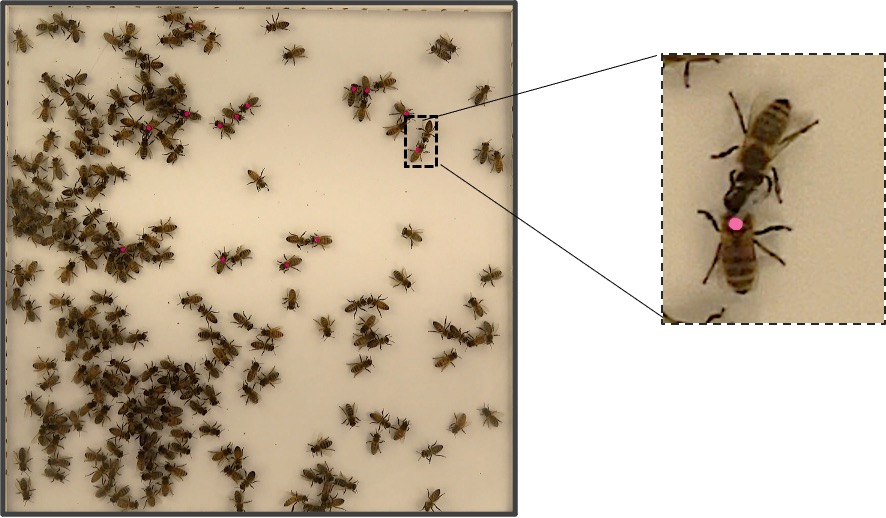Collective behavior in honeybees
Project Description
Division of labor, a hallmark of honeybee behavior, allows the assignment of different tasks to different individuals to improve efficiency. An acute instance of a division of labor occurs as part of their food collection process, where some forager bees collect food and share via food regurgitation, essentially “charging” nestmates who do not have access to a nearby energy source. This process, termed Trophallaxis, allows fast and efficient dissemination of nutrients and is crucial for the colony’s survival. The image below shows an experiment involving the introduction of a number of “feeder” bees, marked with purple dots, into a group of bees that have been deprived of food.
 |
This food-exchange behavior causes a dramatic shift in the morphology of the collection of bees. Initially, the individuals are distributed sparsely across the arena. After the full bees are introduced, clusters appear. Eventually, the clusters dissipate:
 |
A bee that just finished feeding a nestmate faces a dilemma: should it feed another nestmate at the same spot on the honeycomb or move to feed a nestmate at a new place? From statistical physics, we reasoned that moving to a new location to feed nestmates would “seed” new feeding events and thereby contribute to mixing and efficient food dissipation. We have developed an agent-based model to explore this hypothesis and performed a series of simulations to calculate the food distribution and its uniformity across the whole colony. Below is a series of snapshots showing the evolution of this model. The color of each dot represents the food level of that bee-agent.
 |
This provides a useful benchmark to assess the level at which the food distribution rates and efficiency are dependent on parameters such as the fraction of full bees, the movement patterns of each agent, and the duration and amount of food transfer at each interaction. Our results suggest that, to achieve the most efficient food distribution, a full bee may not always choose to feed its immediate neighbors but rather continue her motion to reach a farther bee and share her food at a later time. This pattern of movement ensures that all of the bees, regardless of their position in the colony, will be fed efficiently. These results are currently guiding a set of experiments, intending to link the model to experimental observations by systematically modulating the density of bees in the system and fraction of hungry bees.
Understanding the design principles of food distribution networks in honeybee colonies is not just a problem in ecology or biology, but also one in mathematics and physics, given the exchange of energy and information between individuals as well as between individuals and their physical environment. As this research grows, it has the potential to lead to further insights into the caste systems in honeybee behavior, work distribution within the colony, and energy use of clustered bees over the winter. This has the potential not only to contribute to the future health of honeybee populations, but to inform engineering applications (e.g., distributed charging in swarm robotics).
This project is led by Professor Orit Peleg.
People
- PhD student Golnar Gharooni Fard
- Boulder High School student Charlotte Gorgemans
- Liz Bradley, Professor of Computer Science.
- Orit Peleg, Assistant Professor of Computer Science.
Papers, posters, and talks
- G. Gharooni Fard, V. Deshmukh, E. Bradley, C. Topaz, and O. Peleg, "A Persistent Homology Approach for Characterizing Honeybee Behavior during Food Exchange," SIAM News, December 2021. This is an expanded version of a talk with the same title that was presented at the SIAM Conference on the Applications of Dynamical Systems, Snowbird, UT, (2021).
- G. Gharooni Fard, V. Deshmukh, E. Bradley, C. Topaz, O. Peleg, "A Persistent Homology Approach for Characterizing Honeybee Behavior during Food Exchange,", the IMSI Conference on Topological Data Analysis (2021).
- G. Gharooni Fard, E. Bradley, C. Gorgemans, and O. Peleg, "An Integrated Experimental-modeling Approach to Resource Sharing in Honeybee Swarms," the Robotic-inspired Biology workshop at the International Conference on Intelligent Robots and Systems, IROS (2020).
- G. Gharooni Fard, E. Bradley, and O. Peleg, "Data-Driven Modeling of Distributed Resource Sharing in Honeybee Swarms," Proceedings of the Artificial Life (ALIFE) Conference, 32, 324-332 (2020).
- G. Gharooni Fard, E. Bradley, and O. Peleg, "Data-Driven Modeling of Distributed Resource Sharing in Honeybee Swarms," ACM Collective Intelligence (2020). Search for the paper number (57) to get the extended abstract and a link to the talk.
- G. Gharooni Fard, E. Bradley, C. Gorgemans, and O. Peleg, "On the Efficiency of Food Distribution via Trophallaxis in Honeybees: An Agent-Based Model Approach," the SIAM Conference on the Applications of Dynamical Systems, Snowbird, UT, (2019).
- A feature about this project and its people, entitled "It takes a hive: community volunteers in honey bee research", from the University of Colorado College of Engineering and Applied Science.
Links
- The Peleg Lab website
- The Robinson Lab website
- The Feinerman Lab website
- The LeBoeuf Lab website, which has a great video explaining trophallaxis for lay audiences
Support
- This material is based upon work supported in part by the BioFrontiers Institute at the University of Colorado and in part by the NSF under contract #2014212. Any opinions, findings, and conclusions or recommendations expressed in this material are those of the author(s) and do not necessarily reflect the views of the NSF.
![]()